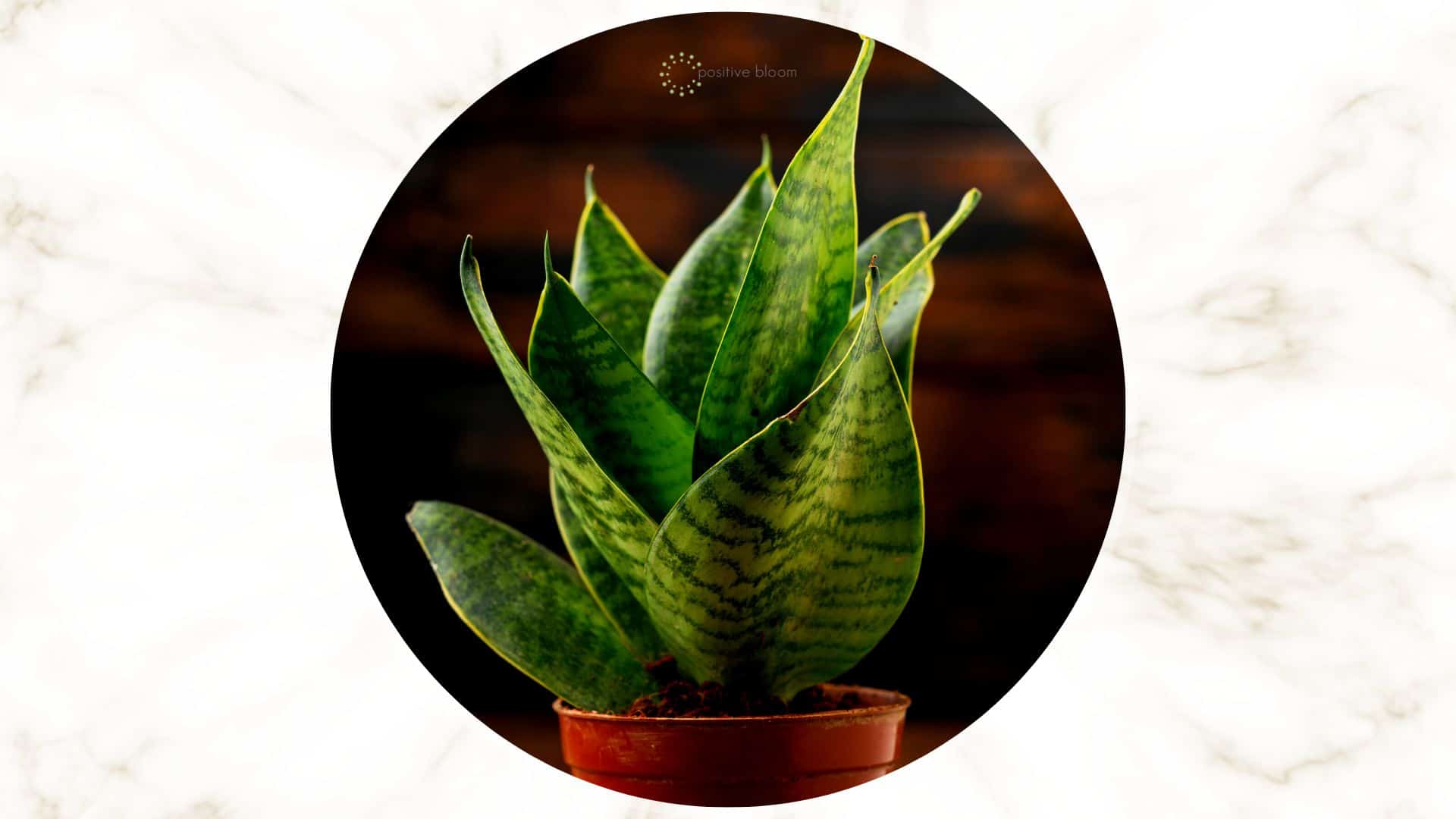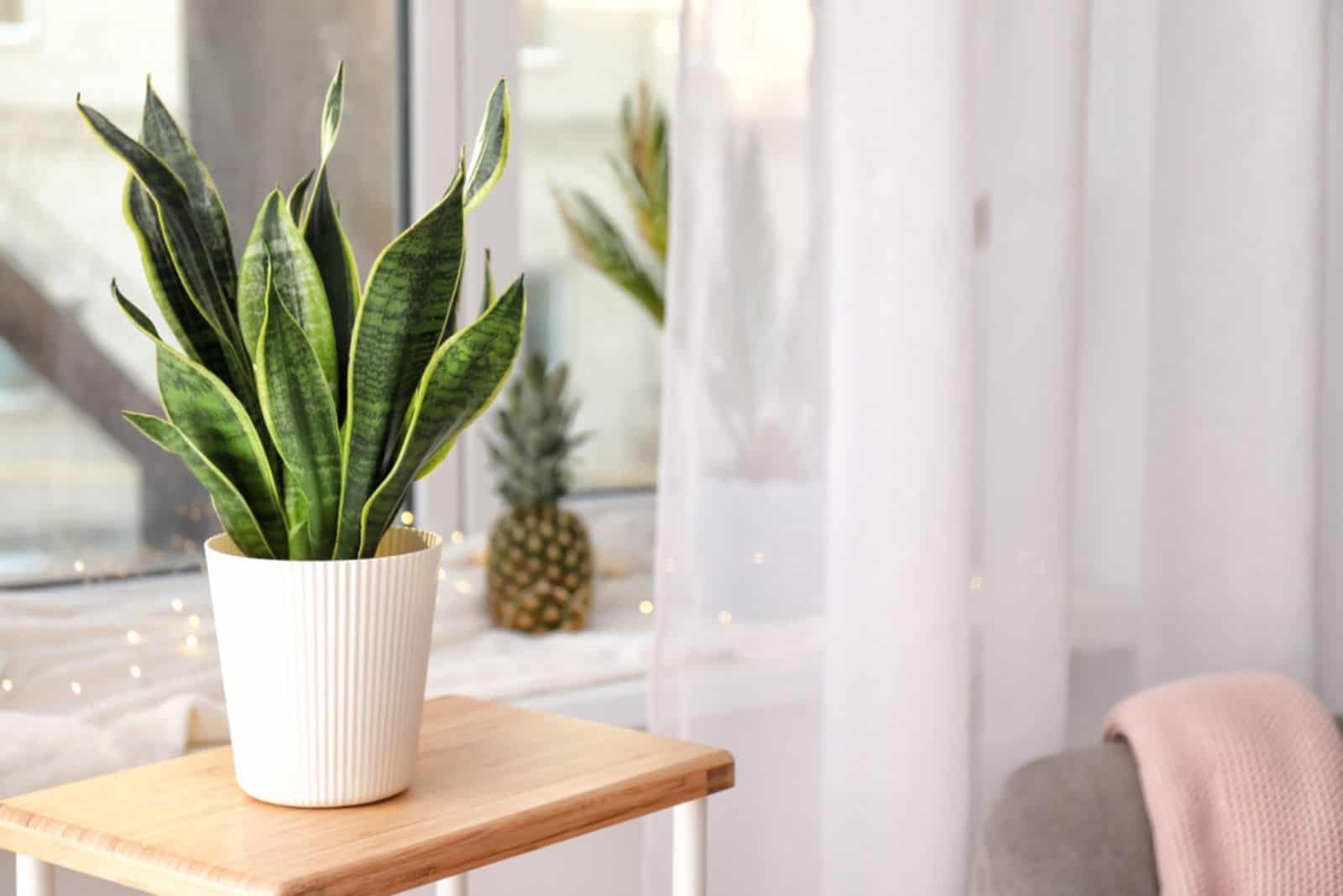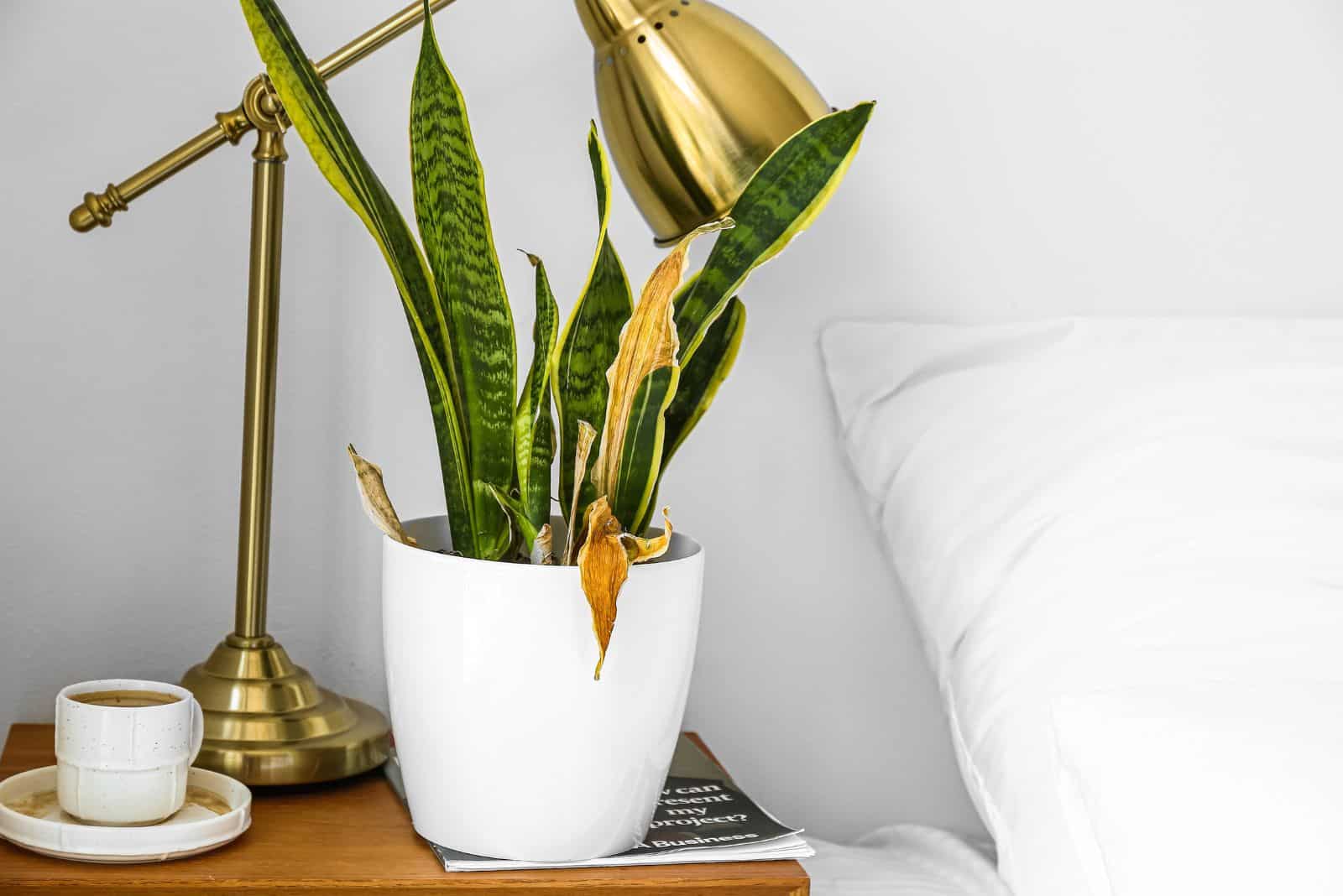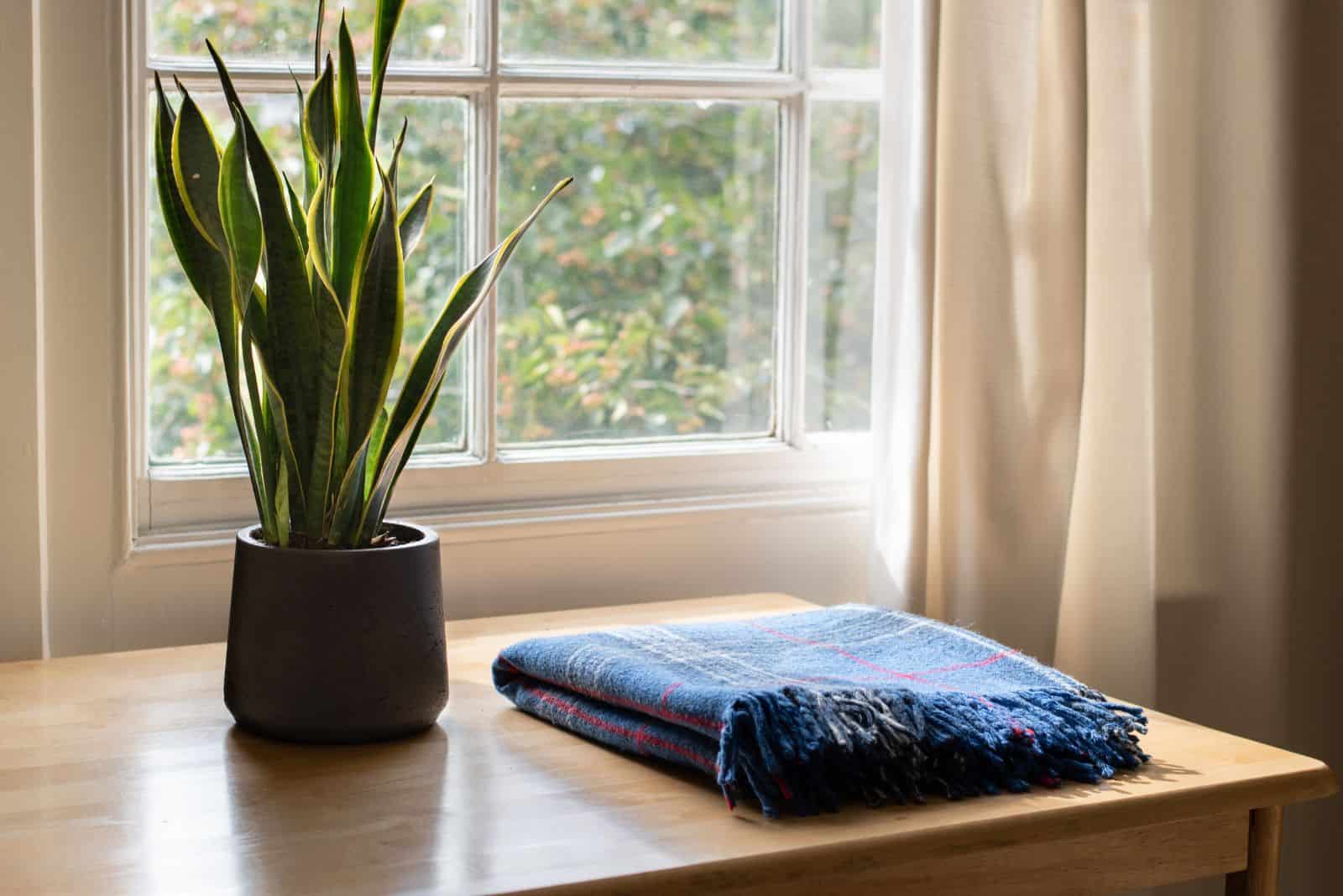Snake plants are popular houseplants that we all love for their unique, flame-like foliage and interesting variegations.
But another reason many growers choose precisely this species to be their indoor buddy is their easy care requirements.
Basic snake plant care tips include keeping this plant in bright light, watering it when the topsoil dries out, and fertilizing it from time to time.
Of course, there are more things you should be mindful of when caring for this houseplant, and we’ll discuss them all in the following sections.
This article also brings you the most common issues that you might have to deal with, such as pests and diseases, leaf discolorations, splitting leaves, etc.
Finally, we’ll present some of the most popular snake plant varieties so that you can decorate your home with more than just one of these amazing houseplants.
Before we go into detail about any of these issues, let’s learn some basic specifics about snake plants:
[table id=685 /]
Snake Plant Care Guide
The snake plant care instructions are fairly simple: expose it to bright indirect sunlight, water it once the topsoil dries out, keep it in warm temperatures, and fertilize it a couple of times a year for the best growth.
This plant doesn’t require any particular humidity levels or pruning, although you will have to pay attention to its soil and repotting requirements if you want it to thrive.
If you don’t meet its requirements, you’ll soon notice that your snake plant is not growing, which is a sign to adjust your plant care routine.
Now let’s learn some more things about its basic requirements so that you can care for it properly and nurture healthy plants.
Light Requirements
Snake plants are perfect houseplants because they can adapt to low and high light levels alike.
Of course, they will grow faster if you expose them to more light, but direct sunlight can burn its delicate foliage, so you shouldn’t expose it to it too much.
Instead, keep your snake plant on an east or south-facing windowsill where it will get plenty of direct sunlight during the morning and late afternoon (when it isn’t that harsh).
You can also grow it in the western part of your home if that’s where you like it best, but in this case, place it at least 2-3 feet away from the windows so that the direct sun cannot burn its foliage.
But don’t get me wrong. You can grow this plant in full sun and it will work, though you’ll have to invest a lot of time into gradually exposing it to higher light levels before you can move it to such a location for good.
Water And Humidity
What makes snake plants perfect for beginners are their low watering requirements.
We generally recommend irrigating indoor snake plants every other week or whenever you notice that the potting mix is dry.
In winter, on the other hand, you’ll have to water it even less frequently (about once a month) as the growing medium dries out slower and the plant’s moisture needs are lower.
When watering your snake plant, remember to use distilled or rainwater since they don’t contain any substances that can accumulate and hinder proper uptake of water and nutrients.
You can use tap water, but allow it to sit for at least 24 hours prior to using it so that at least the chlorine can evaporate. Tap water may also contain a lot of fluorides that can vanish into thin air, so it’s not the best choice.
Finally, only irrigate your snake plant in the morning or at least late afternoon so that the plant can hydrate for the day, but still remain dry around its roots.
Humidity
The snake plant likes consistent humidity levels between 30-50%. And this characteristic makes it perfect for everyone since the average home air moisture levels are in this range.
You should make sure that the humidity doesn’t fluctuate too much since that can weaken your plant and put it in a state of shock.
Particularly high humidity can even increase the risk of pest infestations, so keep your snake plant away from monsteras, philodendrons, and anthuriums. (1)
Temperature
The temperature tolerance for snake plants is between 45-100 degrees Fahrenheit.
But even though this species can survive in these conditions, it doesn’t mean that you should expose them to it.
Instead, keep your snake plant at room temperature or conditions ranging between 60 and 80 degrees Fahrenheit.
Furthermore, 45 degrees is the lowest temperature this plant can tolerate and survive in, and if conditions get this cold, consider taking your snake plant indoors and keeping it warm.
Finally, you should avoid placing plants near drafty locations such as old windows, doors, AC vents, heaters, etc. The temperature in these places constantly changes from low to high, which can stress out your plant.
Soil And Fertilizer
The best potting medium for snake plants is light, loose, and well-draining. Regular potting mixes aren’t the greatest choice because they usually have high peat or coco coir content and retain too much moisture.
Instead, plant this variety in a general-purpose cactus or succulent growing medium that has ample drainage.
You can use it on its own and water your plant more frequently or mix it with three parts traditional high-quality potting soil and some compost for less frequent watering and more fertility.
You can also grow your snake plant in a regular, well-draining potting soil amended with pumice or perlite, but remember to irrigate it only when the substrate completely dries out.
Optimal drainage doesn’t only come from the type of potting medium you use – containers can make a great difference.
For instance, the best planter for snake plants is made from terracotta and has drainage holes.
Terracotta is more porous and holds less moisture, while the holes in the bottom of the pot allow the excess water to leave rather than clog your plant’s roots.
Fertilizer
Snake plants are native to infertile and rocky regions, so they don’t require frequent or ample fertilization.
We prefer using well-balanced and slow-release fertilizers (such as triple 10) 1-2 times per year. These will ensure your plant gets enough nutrients without you having to feed it regularly.
You can also use some worm castings, again in spring, if you prefer more natural options.
You should also never feed these plants in winter since that would only damage their roots. They don’t require any additional nutrients during this period either, so it’d be just a waste of product.
Finally, always irrigate your plant thoroughly after feeding it with fertilizers to make the minerals more available, “reduce” their concentration, and prevent root burn.
Pro tip: If you put compost into your potting mix or order a growing medium that has added plant food, don’t fertilize your dracaena for at least three months, or as long as it takes for the plant to use all the food (this is indicated on the package).
Repotting
Repotting snake plants is one of the simplest things about its plant care because you don’t have to do it more than once every 3-4 years. Yes, this plant likes to be potbound, and you won’t notice it deteriorating like some other houseplants.
However, once it gets 2-3 times larger than its container, you should consider moving it into a bigger one.
The best time to do this is in spring and summer since the plant will have more than enough time to recover from the transplant shock before the chilly winter arrives and it enters dormancy.
When repotting your potbound snake plant, you should gently separate it from the walls of the container using a dull knife or some similar tool. Then try to lift it out of its old pot or lay it aside and pull gently at the base and the soil.
The next step is to put some growing medium into the new container, loosen up the plant’s root system, and fill the pot with more soil.
Place your repotted plants away from direct sunlight, water them 1-2 days after repotting, and they’ll recover from the transplant shock much faster.
Here are some more quick tips for transplanting dracaenas:
Pruning
Snake plants do require some pruning, but this chore isn’t so difficult or frequent you need to be afraid of it.
For instance, you should trim your snake tongue to encourage new growth, keep it in shape, maintain a certain size, and keep it healthy by removing old, damaged, split, and diseased foliage.
If you want to cut this plant to encourage new growth or remove a bit more foliage to keep it compact, you should do it at the beginning of its growing season since that’s when the plant can push out new growth rapidly.
And if you just want to get rid of damaged and diseased foliage, you can do it whenever you want to.
We have some other tips on how to prune snake plants, such as using sterilized scissors and cutting the leaves at their base (since they won’t obtain new shape if you cut them in half).
Pruning can come as a bit of a shock to your plant, so you should refrain from watering for a couple of days and keep it away from direct sunlight afterward.
Propagation
There are a couple of snake plant propagation methods, such as using leaf cuttings and putting them in soil or water, and by dividing this plant’s rhizomes.
We’ll discuss all these methods and techniques so that you can find the one that suits you best.
Propagation By Leaf Cuttings
The first thing you need to do when propagating leaf cuttings is decide whether you want to put them in soil or water. However, the first step is always the same: select a healthy snake plant leaf and cut it as close to the base as possible.
If the leaf is rather large, you can cut it into smaller pieces and get even more snake plants. Cut the end part into a V to increase the surface that will come into contact with the soil or water.
After cutting, let the leaves form a callus, which will ensure a higher success rate.
Then plant the leaf cuttings in a moist, well-draining potting medium or place them in a glass jar filled with water. Only plant (or submerge) the bottom part of the leaf, leaving the upper one free from the substrate or water.
If you opt for soil propagation, cover the leaf cuttings with a humidity dome or a plastic wrap to increase humidity and support rooting. Also maintain consistent moisture in the growing medium because your cutting will die if it gets dry.
When it comes to water propagation, make sure you change the water every couple of days to keep it fresh and clean (or whenever it gets murky and foggy).
Expose your cuttings to warm temperatures and indirect light, and they’ll soon develop new root systems.
Once the roots appear and have gotten a bit stronger, you can repot your cuttings into pots.
And if you’ve decided on soil propagation, you’ll know it was a success if you see roots coming out of the nursery tray or feel some resistance when trying to pull the leaf out (gently, though).
In this video, you can find some more excellent tips for rooting snake plant leaf cuttings, and even dividing the rhizomes (which we’ll talk about in the following section):
Propagation By Division
The snake plant produces new shoots every once in a while, and you can divide that new growth to get new plants ready to be repotted and exhibited in the best spot in your home, or gifted to friends and family.
Step 1. First, take the entire plant out of its container to get a better look at its roots.
Step 2. Find the shoot you wish to propagate and examine its root system. You should always aim to divide parts that have at least 2-3-inch long roots.
Step 3. Take a sharp, disinfected knife and cut as close to the parent plant as possible.
Step 4. Once you divide the rhizomes, it is time to pot all those new (and old) plants. Choose a well-draining potting mix and place some of it in the container. Then plant your snakes and cover their roots with more substrate.
Step 5. The final step is to water all your dracaena plants thoroughly and move them to a location with bright indirect light.
Common Issues
Snake plants are resilient and almost indestructible plants. Therefore, they don’t usually get infested with pests, although it can happen. More common issues are root rot, splitting leaves, and foliage discolorations.
Don’t worry, we’ll discuss all these problems in the following sections so that you can save your plant and keep it healthy.
Pests
The most common bugs you can find on your snake plant are the usual houseplant pests, such as mealybugs, spider mites and, occasionally, aphids.
These critters attack weak plants, so make sure not to overwater and raise indoor humidity.
If they do find a way onto your snake tongue, you can get rid of them with insecticidal soaps, neem oil, or by using some other organic pesticide you have available.
You can use regular insecticides, but they’re not that environmentally friendly so we tend to stay away from them if we can.
Diseases
Snake plants are quite susceptible to root rot since they cannot tolerate being waterlogged.
If that happens, you’ll quickly notice symptoms such as paling and yellowing of the foliage, cessation of growth, wilting, and a rotting smell spreading from the planter.
And if you notice any of these symptoms, you need to examine the snake plant roots immediately, and if they are dark and soft you should remove them at once.
Afterwards you can spray some fungicide (but you don’t have to since they are usually used as a preventive measure) and repot your plant into fresh soil and a clean planter.
Don’t water your snake plant for the following 1-2 weeks so the roots can recover, and place it in indirect light to get more strength. Remember, overwatering is one of the most common causes of a dying snake plant.
Leaf Discolorations
Most snake plant varieties are variegated, so you might not notice that something’s wrong with their color at first.
But if your indoor friend seems to turn pale, it might be that it needs more light or is potbound (which is more likely).
If your plant needs greater sun exposure, simply move it closer to an east- or south-facing window, but do it gradually so that the light doesn’t damage its leaves even more.
On the other hand, you can tell that your plant is pot bound if it’s 2-3 times larger than its container, which is your cue to repot it.
This issue is closely related to nitrogen deficiency, which is another common reason for pale and yellow foliage.
Therefore, remember to feed your snake plants at least once a year with a balanced fertilizer or worm castings, or repot them more frequently to replenish the soil nutrients.
Sometimes your snake plant’s leaves will turn yellow and brown due to excess light, so make sure that you don’t expose it to direct sunlight during the hottest part of the day.
Finally, overwatering and root rot can also result in yellow foliage, so don’t forget to check for this cause as well, especially if you’ve ruled out other causes.
Splitting Leaves
Finally, the splitting of snake plant leaves is another thing that can happen to your colorful friend, and the most common causes include overwatering, extremely low humidity, physical damage from pets and careless handling, extreme temperatures, or boron deficiency.
Since there are quite a few reasons, you should consider each of them before ruling them out and treating your plant for overwatering, let’s say.
If you have pets, it is likely that they nibble on it.
But if the soil is wet or you can feel low humidity levels, you should treat this differently.
Furthermore, boron deficiency is indicated by dying tips, wrinkly and brittle foliage, downward curling of young leaves, and overall paleness. (2)
Popular Snake Plant Varieties
And now all that’s left for us to do is examine some common snake plant species that are incredibly easy to care for, but can bring so much to your home decor.
Mother-in-law’s tongue – The flame-like foliage rising from the rhizomes are dark green with a paler green shade and yellow tones decorating the middle and the edges.
Moonshine snake plant – This species has broad foliage with a slight curl inside and relaxing pale silver-green shades.
Bird’s Nest snake plant – The dark and shiny leaves are clustered into succulent-like rosettes and decorated with silver-green horizontal stripes.
Black Coral snake plant – This plant is just a cultivar of the regular snake plant, so it does resemble the mother-in-law’s tongue aside from its truly dark green leaves and gray-green variegations across the entire surface.
Cylindrical snake plant – Unlike other varieties mentioned above, the cylindrical snake plant has columnar foliage that are clustered in rosettes and decorated with silver-green lines.
FAQ
What are the benefits of snake plants?
The snake plant is an oxygen supplier because it converts carbon dioxide to oxygen, and it can also remove pollutants such as formaldehyde, benzene, toluene, etc., from the indoor air. (3)
This plant (among many others) also benefits well-being and promotes feelings of happiness and calm. (4)
What is the lifespan of snake plants?
Plants from the genus Dracaena can live up to 25 years with proper care, but their usual lifetime lasts between 5-10 years.
However, they constantly produce new shoots that you can divide to get new plants that are just starting their life.
Final Thoughts
Snake plant care is incredibly simple, which makes them ideal for beginners.
Expose your plant to indirect light, water it every 1-2 weeks, fertilize it once or twice a year, and plant it in a well-draining growing medium.
It doesn’t require high humidity, you don’t have to prune it that often (unless you want to control its growth), and you only need to repot it every 3-4 years (or when it gets much too large for its pot).
It’s also not that susceptible to pests, but it’s been known to happen, especially if it’s weakened by overwatering.
Speaking of overwatering, this issue can lead to root rot, a common problem with dracaenas along with splitting leaves and leaf discolorations.
The good news is that you can prevent every one of these issues by following our care guide and meeting your plant’s requirements.
Finally, we included a couple of popular types of snake plant just in case you want another one for your indoor decor.
Until next time!
[sp_easyaccordion id=”18741″]





